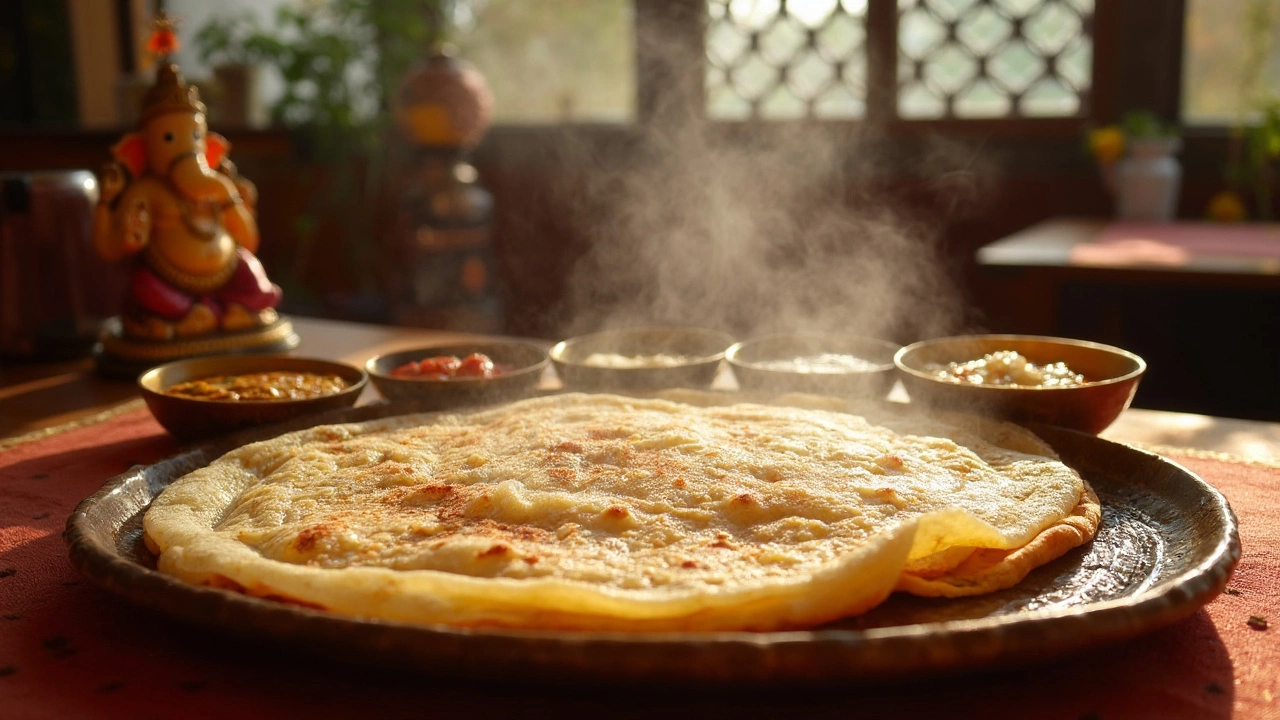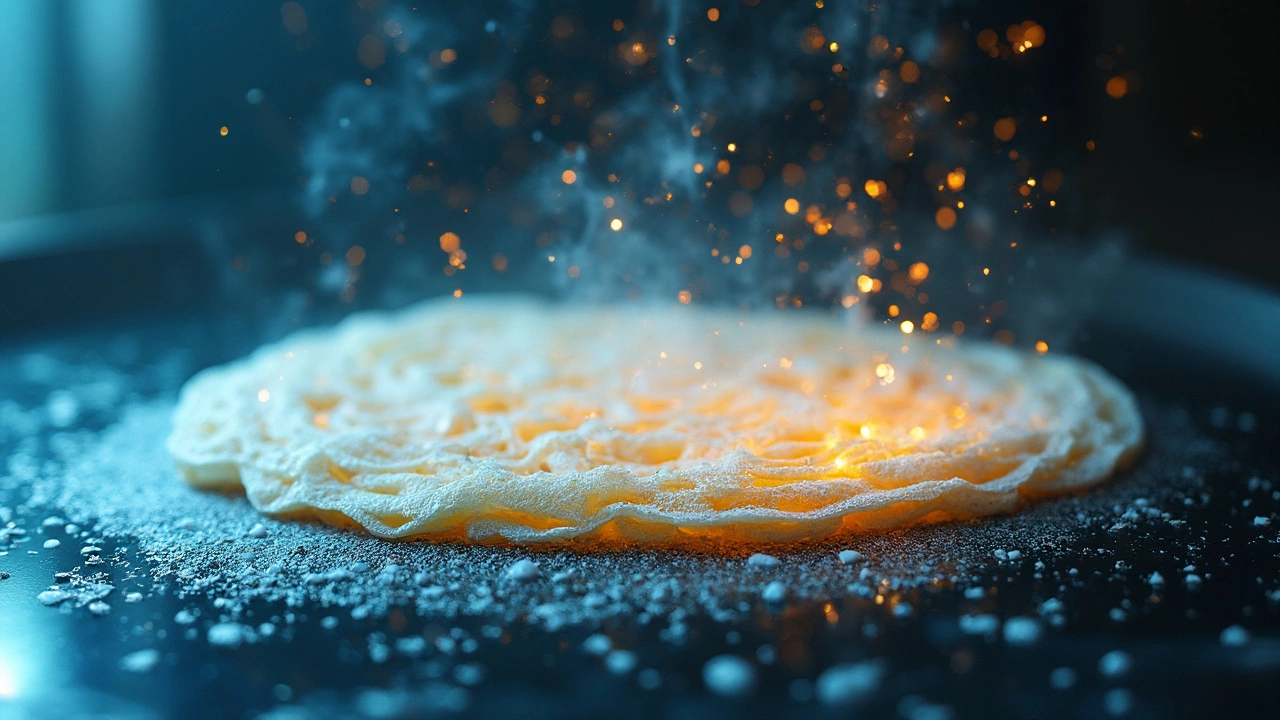How to Make Dosa Batter Rise Quickly Without Using Yeast
 Feb, 15 2025
Feb, 15 2025
Ever craved dosas but felt disheartened by the hours it usually takes for the batter to ferment? No fret! You can actually speed up the process without turning to yeast. Let’s explore how to make that happen.
First things first, what makes dosa batter rise? It’s all in the fermentation which usually relies on natural bacteria. But what if we could help nature along a bit?
Temperature plays a huge role here. Keeping the batter in a warm spot, say near a window with sunlight or even in your oven with just the light on, can kickstart and speed up fermentation. No sunlight? No problem. Just set your oven at its lowest setting for a few minutes, then turn it off and let the batter rest in there.
- Basics of Dosa Batter Rising
- Why Skip Yeast?
- Temperature and Its Role
- Natural Boosters for Quick Rise
- Testing and Storing Tips
Basics of Dosa Batter Rising
If you're aiming for that perfect dosa, understanding what makes the dosa batter rise is key. It's all about the fermentation process, which relies on the right mix of rice and urad dal, temperature, and time. When done correctly, it gives you the light, fluffy texture that's a hallmark of a great dosa.
Most folks have their own take on the ratio, but a solid starting point is three parts rice to one part urad dal. This combo ensures the batter structure is just right. Soak them separately, then grind them fine. Mixing them together and letting them rest is where the magic begins.
Fermentation Factors
Fermentation mainly depends on ambient temperature. Warmer environments work like a charm, speeding up the natural process and helping the batter rise quickly. Remember, patience is part of the game. Usually, it takes about 8 to 10 hours but we'll explore how to cut this short, as explained in other sections.
In places with colder climates, you might need to get creative. Think warm spaces like an oven with only the light turned on, or even using a dehydrator if you're in a pinch. These little tricks can save hours.
The Role of Bacteria
The batter's rise is all about those microorganisms doing their job. These natural bacteria convert the sugars in rice and dal into lactic acid, creating that tangy taste and bubbly texture, and skipping the need for yeast while keeping things authentic.
Why Resistance Matters
Ever wonder why your kitchen sometimes seems to fight back? It's because the minerals and hardness of the water can influence fermentation. Soft water is more fermentation-friendly, so if you're dealing with hard water, a simple solution is filtering it or using bottled water.
| Ingredient | Soak Time (Hours) |
|---|---|
| Rice | 4-6 |
| Urad Dal | 2-4 |
A quick tip: once the batter looks bubbly and has a bit of rise, you're on the right path. It's ready to transform into crispy golden dosas. Now that you're equipped with the basics, you're ready to tweak things and find your own groove.
Why Skip Yeast?
Using yeast isn't common in traditional dosa making, and there's a good reason for it. Yeast can alter the authentic taste and texture that we love in a classic dosa. The natural fermentation process not only gives your dosa its signature flavor but also adds mild tanginess which yeast really can't offer.
Dosa batter relies on natural bacteria from the soaked rice and urad dal. Nature does its magic, breaking down complex carbohydrates and proteins, making dosas not just yum but also easier to digest. Introducing yeast can fast-track rising, but it might overshadow the nutty-sweet flavors typical of a well-made dosa.
Health Benefits of Skipping Yeast
Aside from taste, skipping yeast can also be beneficial for folks who might have yeast sensitivities. Fermented foods like dosa provide probiotics that help in gut health—no artificial additives required!
Embracing Natural Methods
Let’s face it, traditional methods have stood the test of time for good reason. When you allow nature to do its work, you're not just making dosa batter rise; you're nurturing that authentic gastronomic experience rooted in culture and tradition.
So, next time you’re about to reach for yeast, think about the flavorful goodness you're missing. It’s totally worth the wait when you bite into that perfectly crispy dosa, knowing it’s the real deal.

Temperature and Its Role
Temperature is crucial when it comes to making your dosa batter rise quickly. You don't need a fancy kitchen setup to get this right—just a few tricks up your sleeve can make a big difference.
Understanding Temperature's Impact
Fermentation happens when natural bacteria in the batter generate carbon dioxide. Warmer temperatures speed up this process, which helps your batter puff up faster. Too cold, and you might as well be waiting for paint to dry.
Simple Ways to Keep It Warm
Here’s the kicker: you can use household stuff to create the perfect warm spot for your dosa batter.
- Oven Magic: Preheat your oven to the lowest setting for a few minutes, then turn it off. Pop your batter in there, and let it bask in the residual warmth.
- Sunlit Spot: If it’s daytime, find a window with sunlight. The natural heat can do wonders.
- Wrap It Up: Swaddle your batter bowl with a thick cloth or even towels. This helps trap the warmth in.
Get Precise with Gadgets
If you’re a gadget person, a digital thermometer can be your new best friend. Aim for a temperature range between 30°C to 35°C (86°F to 95°F) for optimal fermentation.
Temperature adjustments might seem small, but they pack a punch in speed and fluffiness. Try them, and say goodbye to yeast in your dosa batter!
| Temperature | Time for Rise |
|---|---|
| 30°C (86°F) | 6-8 hours |
| 35°C (95°F) | 4-6 hours |
Natural Boosters for Quick Rise
Alright, let's jazz up the process with some nifty natural boosters to get your dosa batter rising in no time! Forget the yeast; we've got some cool tricks to help.
Fenugreek Seeds
Fenugreek seeds are like gold in the dosa-making world. These tiny seeds can help the batter rise faster. Just add a teaspoon while soaking the rice and urad dal. They not only speed up fermentation but add nutritional value as well.
Poha (Flattened Rice)
Poha is another secret weapon. Soak a handful of poha with your rice. It ferments quickly and gives a nice texture to the dosa batter. The starches in poha break down faster, helping the batter rise without any extra effort.
Secret Ingredient: Sugar
Adding a pinch of sugar can do wonders. Sugar acts as a food source for those natural bacteria, giving them an energy boost to work their magic more rapidly. Just a pinch and no more; otherwise, you could affect the taste.
Warm Water
The temperature trick doesn’t stop at room temp. Mixing your batter with warm water can help. The warmth stimulates the bacteria and fermentation, working faster than usual.
Probiotic Punch
Here’s an innovative idea. A spoonful of probiotic yogurt or buttermilk kickstarts fermentation. It introduces extra bacteria and speeds up the whole shebang.

Testing and Storing Tips
So, you've got your dosa batter ready and raring to go. But how do you know if it's truly ready? Well, let’s put it through a simple test: give it a little nudge. A properly fermented batter should look bubbly and rise slightly. Another trick? Drop a small amount of the batter into a glass of water; if it floats, it's good to go!
Now, once you have your perfectly fluffed-up batter, you'll want to store it right to keep it at its best. Here’s the deal: pop it in the fridge. While it might seem like a no-brainer, there’s a bit more to it to ensure your batter stays usable for longer.
Storing Smart
- Use an airtight container to keep out moisture and unwanted odors.
- If you plan on using it over several days, only bring out what you need and keep the rest chilled.
- Don’t forget to give it a gentle stir before you use it again.
How Long Does It Last?
Be mindful of the shelf life. In a well-sealed container, dosa batter can last in the fridge for about 4-5 days. If you're pushing beyond that, consider freezing the leftovers in portions. It’s perfect for when the next big dosa craving hits!
Just follow these testing and storing tips, and you'll have dosa batter that's always ready to rise to the occasion—even without yeast.